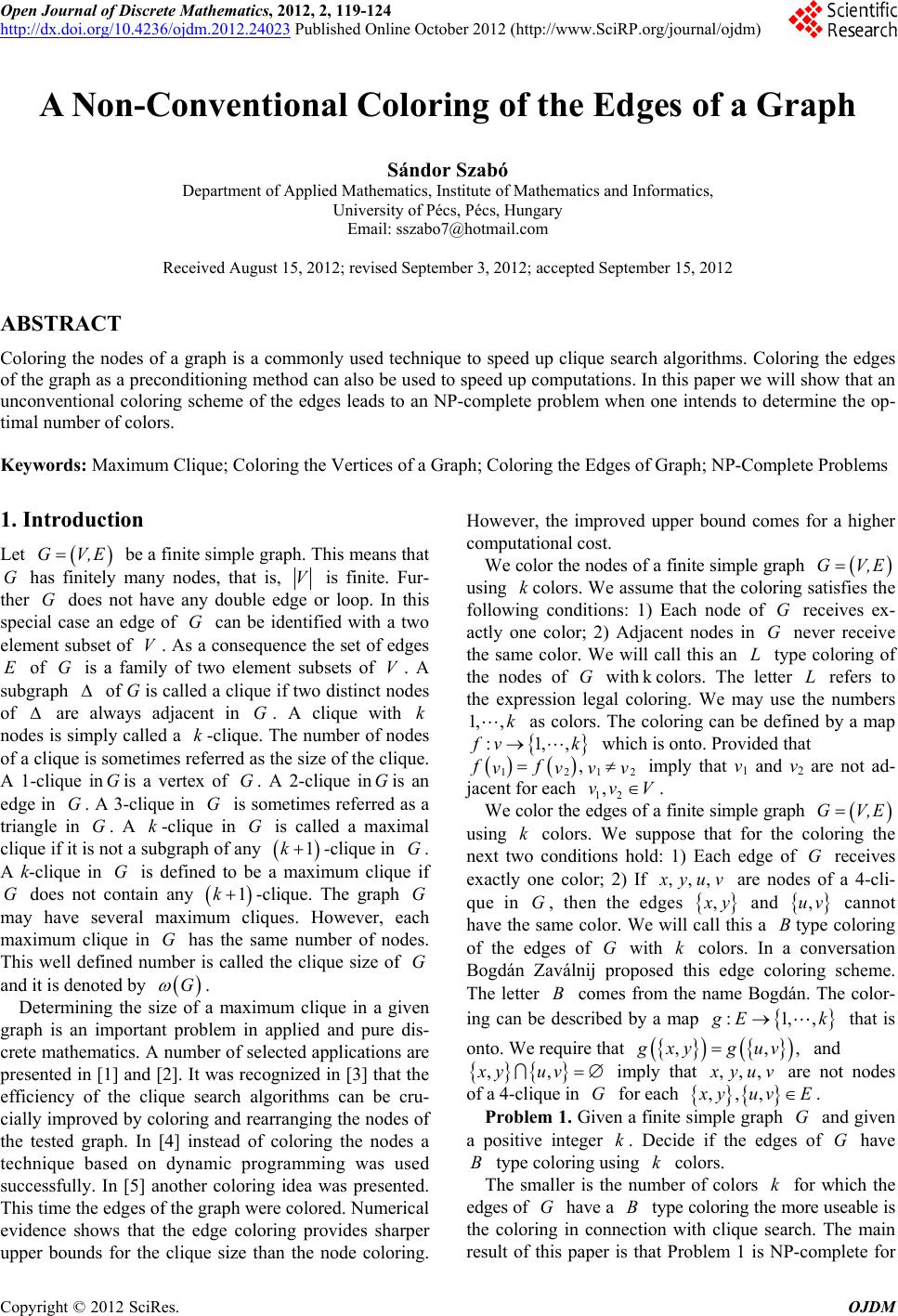 Open Journal of Discrete Mathematics, 2012, 2, 119-124 http://dx.doi.org/10.4236/ojdm.2012.24023 Published Online October 2012 (http://www.SciRP.org/journal/ojdm) A Non-Conventional Coloring of the Edges of a Graph Sándor Szabó Department of Applied Mathematics, Institute of Mathematics and Informatics, University of Pécs, Pécs, Hungary Email: sszabo7@hotmail.com Received August 15, 2012; revised September 3, 2012; accepted September 15, 2012 ABSTRACT Coloring the nodes of a graph is a commonly used technique to speed up clique search algorithms. Coloring the edges of the graph as a preconditioning method can also be used to speed up computations. In this paper we will show that an unconventional coloring scheme of the edges leads to an NP-complete problem when one intends to determine the op- timal number of colors. Keywords: Maximum Clique; Coloring the Vertices of a Graph; Coloring the Edges of Graph; NP-Complete Problems 1. Introduction Let be a finite simple graph. This means that has finitely many nodes, that is, GV,E GV is finite. Fur- ther does not have any double edge or loop. In this special case an edge of can be identified with a two element subset of . As a consequence the set of edges of G is a family of two element subsets of . A subgraph of G is called a clique if two distinct nodes of are always adjacent in G. A clique with nodes is simply called a -clique. The number of nodes of a clique is sometimes referred as the size of the clique. A 1-clique inGis a vertex of . A 2-clique inis an edge in . A 3-clique in is sometimes referred as a triangle in . A -clique in is called a maximal clique if it is not a subgraph of any -clique in . A k-clique in is defined to be a maximum clique if does not contain any G GG G G k V k E G V G k G G G G k 1k 1 -clique. The graph may have several maximum cliques. However, each maximum clique in has the same number of nodes. This well defined number is called the clique size of and it is denoted by . G G G G Determining the size of a maximum clique in a given graph is an important problem in applied and pure dis- crete mathematics. A number of selected applications are presented in [1] and [2]. It was recognized in [3] that the efficiency of the clique search algorithms can be cru- cially improved by coloring and rearranging the nodes of the tested graph. In [4] instead of coloring the nodes a technique based on dynamic programming was used successfully. In [5] another coloring idea was presented. This time the edges of the graph were colored. Numerical evidence shows that the edge coloring provides sharper upper bounds for the clique size than the node coloring. However, the improved upper bound comes for a higher computational cost. We color the nodes of a finite simple graph GV,E using colors. We assume that the coloring satisfies the following conditions: 1) Each node of receives ex- actly one color; 2) Adjacent nodes in never receive the same color. We will call this an type coloring of the nodes of with kG G L G colors. The letter refers to the expression legal coloring. We may use the numbers as colors. The coloring can be defined by a map L 1, ,k ,:1, vk which is onto. Provided that , 12 vv 1 v 2 ff v ,vv imply that v1 and v2 are not ad- jacent for each 12 V . We color the edges of a finite simple graph GV,E using colors. We suppose that for the coloring the next two conditions hold: 1) Each edge of receives exactly one color; 2) If kG ,,, yuv are nodes of a 4-cli- que in G, then the edges , y k and cannot have the same color. We will call this a type coloring of the edges of with colors. In a conversation Bogdán Zaválnij proposed this edge coloring scheme. The letter comes from the name Bogdán. The color- ,uv B G B ing can be described by a map :1,, Ek that is onto. We require that ,, , xyg uv and ,,xy uv imply that ,,, yuv ,,, are not nodes of a 4-clique in for each G yuvG E . Problem 1. Given a finite simple graph and given a positive integer . Decide if the edges of have type coloring using k colors. k G B The smaller is the number of colors for which the edges of have a type coloring the more useable is the coloring in connection with clique search. The main k G B result of this paper is that Problem 1 is NP-complete for C opyright © 2012 SciRes. OJDM  S. SZABÓ 120 Table 2. The lists of the neighbors of the nodes in H. 3k. The intuitive meaning of this result is that deter- mining the threshold value of the colors k in Problem 1 is computationally demanding. Consequently, in practical computations we have to resort on approximate greedy algorithms and we have to develop various heuristics. 1 2 6 7 2. The Auxiliary Graph H In this section we construct an auxiliary graph. This will play the role of building blocks in further constructions. Let us consider the graph , VE given by its ad- jacency matrix in Table 1. The graph has 14 nodes 114 and 24 edges. The rows and columns of the adjacency matrix ofare labeled by the nodes. The bul- let in the cell at the intersection of row i and column ,,vv Hv v records the fact that the unordered pair is an edge of , ij vv . The reader will notice that in Table 1 the node i is replaced by , that is, the letter is sup- pressed and only the indexis used. In Table 2 each node and its neighbors are listed. This is another way to describe the graph v iv i . The set of neighbors of the node in is denoted by and by definition . Finally, the geometric re- presentation of the graph vG Nv Nv V :,vx x,Ex is given in Figure 1. Right below each node we recorded the color of the node. But at this moment the reader may ignore the colors. In order to avoid a cluttered figure we used two copies of the nodes 1 and 14 . One can imagine that the figure is drawn on a strip of paper. Then we fold the strip to form a cylinder identifying the shorter sides of the strip. Thus the graph v v is drawn on the surface of a cylinder and we arrange things such that the two copies of coincide 1 v Table 1. The adjacency matrix of graph H. 1 1 111 1 2 3 4 5 6 7 8 9 0 1 2 3 4 1 × ● ● ● ● 2 ● × ● ● 3 ● × ● ● ● 4 ● × ● ● 5 ● × ● ● ● 6 ● ● × ● 7 ● ×● ● 8 ● ●× ● ● 9 ● ● × ● 1 0 ● ● × ● ● 1 1 ● ● × ● 1 2 ● ● ×● 1 3 ● ● ●× 1 4 ● ● ● ● × 11 2 1 3 14 3 2 4 10 12 4 3 5 9 5 4 6 8 13 6 1 5 14 7 1 8 14 8 5 7 9 12 9 4 8 10 10 3 9 11 13 11 1 10 14 12 3 8 13 13 5 10 12 14 2 6 7 11 v 1 2 v 14 3 v 2 1 v 11 1 v 10 c v 3 c v 9 c v 4 c v 8 c v 5 c v 7 1 v 6 1 v 14 3 v 1 2 v 12 c v 13 c Figure 1. Graph H with colored nodes. Copyright © 2012 SciRes. OJDM 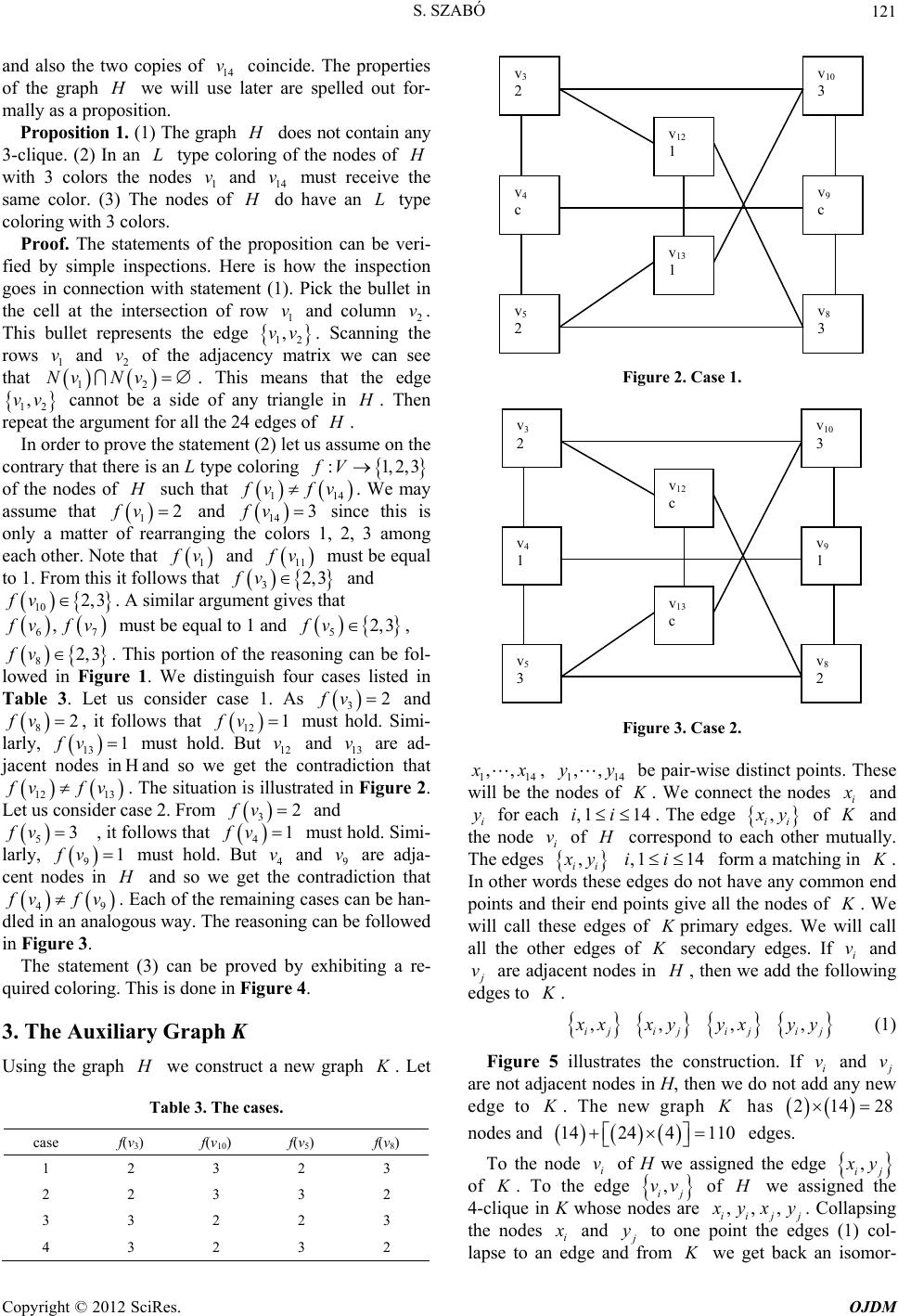 S. SZABÓ 121 and also the two copies of 14 coincide. The properties of the graph v we will use later are spelled out for- mally as a proposition. Proposition 1. (1) The graph does not contain any 3-clique. (2) In an type coloring of the nodes of L with 3 colors the nodes 1 v and 14 must receive the same color. (3) The nodes of v do have an type coloring with 3 colors. L Proof. The statements of the proposition can be veri- fied by simple inspections. Here is how the inspection goes in connection with statement (1). Pick the bullet in the cell at the intersection of row and column 2 v. This bullet represents the edge 12 . Scanning the rows and of the adjacency matrix we can see that 2 . This means that the edge 12 cannot be a side of any triangle in 1 v ,vv 1 v Nv 2 v 1 Nv ,vv . Then repeat the argument for all the 24 edges of . In order to prove the statement (2) let us assume on the contrary that there is an L type coloring :1,2,fV3 of the nodes of such that 14 1 vfv 3 14 fv . We may assume that and since this is only a matter of rearranging the colors 1, 2, 3 among each other. Note that 1 fv 2 1 v and 11 v fv must be equal to 1. From this it follows that and 2,3 3 . A similar argument gives that 10 2,3fv , 67 vfv must be equal to 1 and 52,3fv , 82,3fv. This portion of the reasoning can be fol- lowed in Figure 1. We distinguish four cases listed in Table 3. Let us consider case 1. As 32fv and , it follows that 82fv 12 1fv must hold. Simi- larly, must hold. But 12 v and 13 are ad- jacent nodes inand so we get the contradiction that 12 13 13 fv 1 H v vf 53fv v . The situation is illustrated in Figure 2. Let us consider case 2. From and , it follows that 32fv 41fv v must hold. Simi- larly, must hold. But 4 and 9 are adja- cent nodes in 9 fv 1v and so we get the contradiction that 4 9 vfv. Each of the remaining cases can be han- dled in an analogous way. The reasoning can be followed in Figure 3. The statement (3) can be proved by exhibiting a re- quired coloring. This is done in Figure 4. 3. The Auxiliary Graph K Using the graph we construct a new graph . Let Table 3. The cases. case f(v3) f(v10) f(v5) f(v8) 1 2 3 2 3 2 2 3 3 2 3 3 2 2 3 4 3 2 3 2 v 3 2 v 10 3 v 4 c v 5 2 v 9 c v 8 3 v 12 1 v 13 1 Figure 2. Case 1. v 3 2 v 10 3 v 4 1 v 5 3 v 9 1 v 8 2 v 12 c v 13 c Figure 3. Case 2. 114 ,, x, 114 be pair-wise distinct points. These will be the nodes of . We connect the nodes ,,yy Ki and i for each y,1ii14 . The edge , ii y of and the node of K i v correspond to each other mutually. The edges , ii y ,1 14ii K form a matching in In other words these edges do not have any common end points and their end points give all the nodes of . We will call these edges of primary edges. We will call all the other edges of secondary edges. If i and K. K v K v are adjacent nodes in , then we add the following edges to . K , ij x , ij y (1) , ij yx , ij yy Figure 5 illustrates the construction. If i and v v are not adjacent nodes in H, then we do not add any new edge to . The new graph has 421 28 nodes and 1424 4 110 edges. To the node i of H we assigned the edge v , ij y of . To the edge K , ij vv of we assigned the 4-clique in K whose nodes are jj ,, ii , yxy . Collapsing the nodes i and y to one point the edges (1) col- lapse to an edge and from we get back an isomor- K Copyright © 2012 SciRes. OJDM 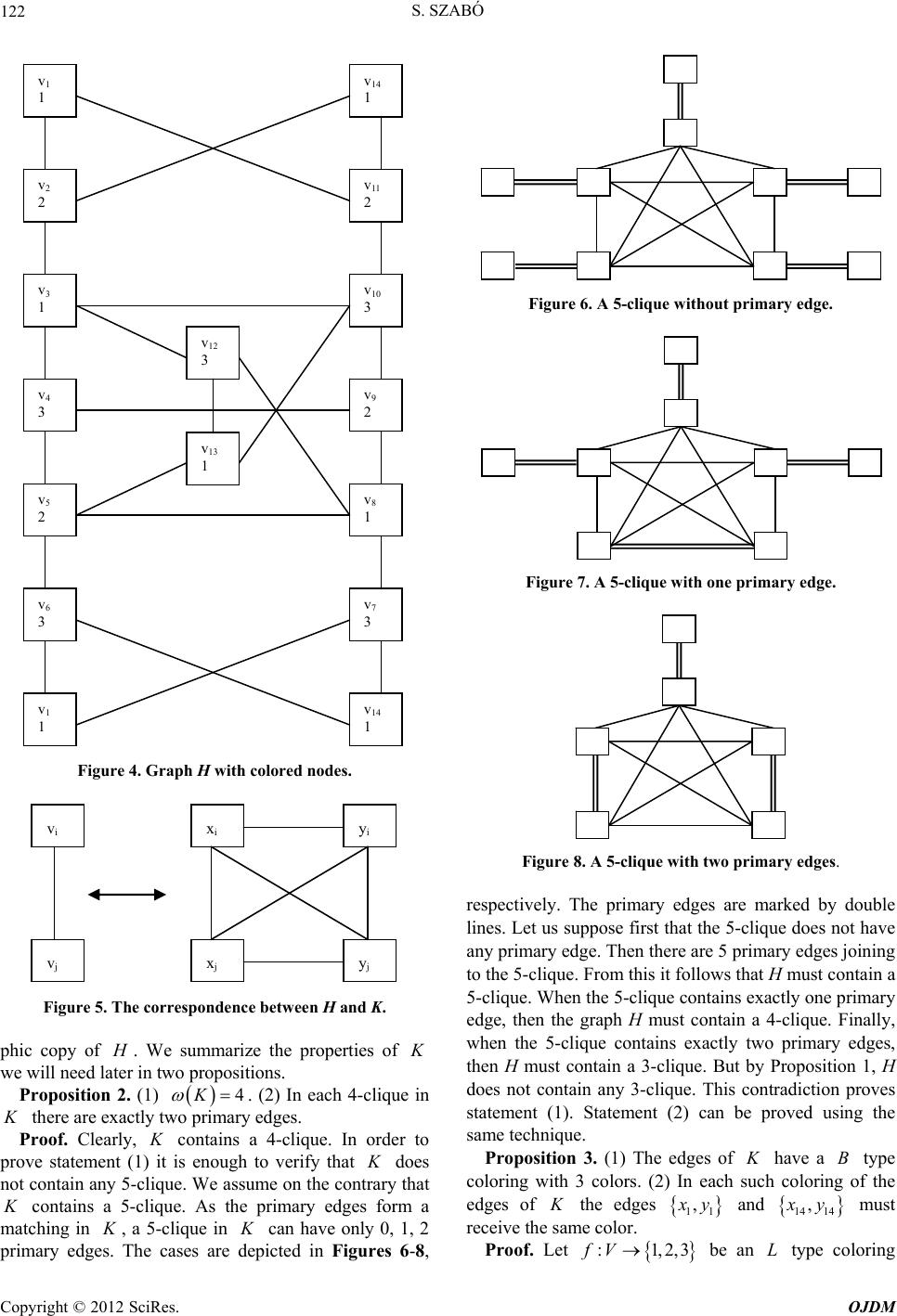 S. SZABÓ 122 v 1 1 v 14 1 v 2 2 v 11 2 v 10 3 v 3 1 v 9 2 v 4 3 v 8 1 v 5 2 v 7 3 v 6 3 v 14 1 v 1 1 v 12 3 v 13 1 Figure 4. Graph H with colored nodes. y j v i v j x i y i x j Figure 5. The correspondence between H and K. phic copy of . We summarize the properties of we will need later in two propositions. Proposition 2. (1) 4K . (2) In each 4-clique in there are exactly two primary edges. Proof. Clearly, contains a 4-clique. In order to prove statement (1) it is enough to verify that does not contain any 5-clique. We assume on the contrary that contains a 5-clique. As the primary edges form a matching in , a 5-clique in can have only 0, 1, 2 primary edges. The cases are depicted in Figures 6-8, Figure 6. A 5-clique without primary edge. Figure 7. A 5-clique with one primary edge. Figure 8. A 5-clique with two primary edges. respectively. The primary edges are marked by double lines. Let us suppose first that the 5-clique does not have any primary edge. Then there are 5 primary edges joining to the 5-clique. From this it follows that H must contain a 5-clique. When the 5-clique contains exactly one primary edge, then the graph H must contain a 4-clique. Finally, when the 5-clique contains exactly two primary edges, then H must contain a 3-clique. But by Proposition 1, H does not contain any 3-clique. This contradiction proves statement (1). Statement (2) can be proved using the same technique. Proposition 3. (1) The edges of have a type coloring with 3 colors. (2) In each such coloring of the edges of the edges K B K 11 , y and 14 14 , y must receive the same color. Proof. Let :1,2,fV3 be an type coloring L Copyright © 2012 SciRes. OJDM 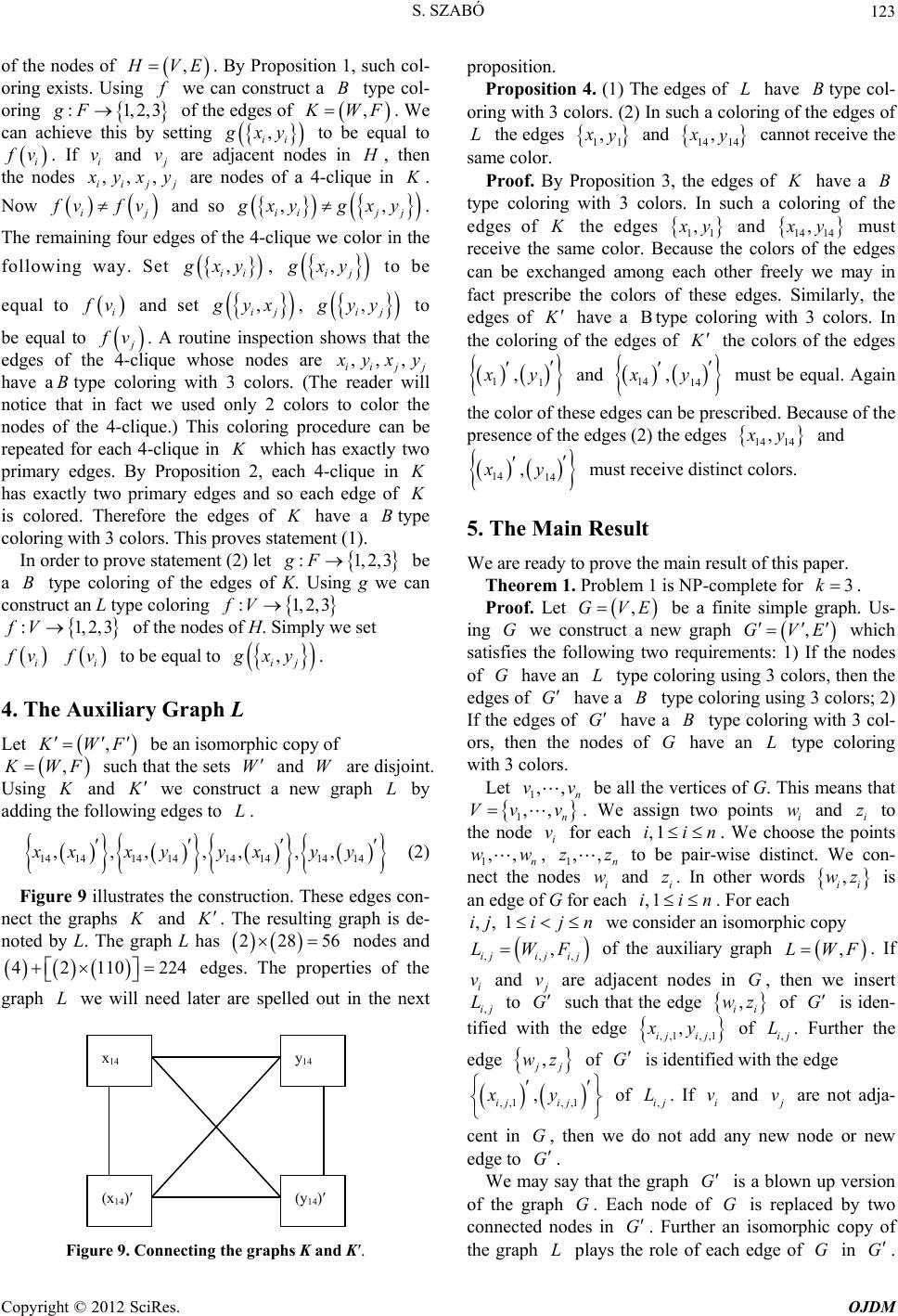 S. SZABÓ 123 of the nodes of , VE. By Proposition 1, such col- oring exists. Using we can construct a type col- oring of the edges of B 1,2,3:gF , WF . We can achieve this by setting , ii xy to be equal to i v. If and i v v are adjacent nodes in , then the nodes ,,, iij j yxy j are nodes of a 4-clique in . K Now i vfv and so j ii j ,, xy , ii g xy. The remaining four edges of the 4-clique we color in the following way. Set xy , , ij xy to be equal to i v and set , ij yx , , ij yy to be equal to v. A routine inspection shows that the edges of the 4-clique whose nodes are iij j , ,, yx B :1,2gF 1, y K K ,3 have atype coloring with 3 colors. (The reader will notice that in fact we used only 2 colors to color the nodes of the 4-clique.) This coloring procedure can be repeated for each 4-clique in which has exactly two primary edges. By Proposition 2, each 4-clique in has exactly two primary edges and so each edge of is colored. Therefore the edges of have a type coloring with 3 colors. This proves statement (1). B :1,2 K K :fV In order to prove statement (2) let be a type coloring of the edges of K. Using g we can construct an L type coloring 2,3 B fV i ,3 of the nodes of H. Simply we set v i v to be equal to , ij xy . 4. The Auxiliary Graph L Let , WF , be an isomorphic copy of WF K such that the sets and W are disjoint. Using and W 14 14 ,xy K we construct a new graph by adding the following edges to . L 14 yy L 14 14 ,,,yx 14 14 ,,xx 14 , (2) Figure 9 illustrates the construction. These edges con- nect the graphs and . The resulting graph is de- noted by L. The graph L has 22 856 nodes and 4 2 110 L 224 edges. The properties of the graph we will need later are spelled out in the next x 14 (x 14 )′ y 14 (y 14 )′ Figure 9. Connecting the graphs K and K′. proposition. Proposition 4. (1) The edges of have type col- oring with 3 colors. (2) In such a coloring of the edges of the edges L B L 11 ,x and 14 ,x14 cannot receive the same color. Proof. By Proposition 3, the edges of have a type coloring with 3 colors. In such a coloring of the edges of B the edges 11 , y and 14 ,14 y must receive the same color. Because the colors of the edges can be exchanged among each other freely we may in fact prescribe the colors of these edges. Similarly, the edges of have a type coloring with 3 colors. In the coloring of the edges of B the colors of the edges 11 ,xy and 14 14 ,xy must be equal. Again the color of these edges can be prescribed. Because of the presence of the edges (2) the edges 14 14 , y and 14 14 ,xy must receive distinct colors. 5. The Main Result We are ready to prove the main result of this paper. Theorem 1. Problem 1 is NP-complete for 3k . Proof. Let ,GVE L be a finite simple graph. Us- ing we construct a new graph which satisfies the following two requirements: 1) If the nodes of have an type coloring using 3 colors, then the edges of G G ,GVE G have a type coloring using 3 colors; 2) If the edges of B G have a type coloring with 3 col- ors, then the nodes of G have an type coloring with 3 colors. BL Let be all the vertices of G. This means that 1,, n vv 1,, n v i v Vv . We assign two points i and i to the node for each w z ,1iin i z . We choose the points 1, 1 to be pair-wise distinct. We con- nect the nodes i and . In other words ,,n wwz,, n wz ii wz, is an edge of G for each ,1iin . For each ,,1ijijn we consider an isomorphic copy ,,, , ijijij LWF of the auxiliary graph ,LWF. If i v and v G are adjacent nodes in , then we insert to G ,i Lj such that the edge of , ii wz G is iden- tified with the edge L ,,1 ,,1 , ij ij xy of . Further the ,ij edge , j wz of G is identified with the edge ,,1 ,,1 , ij ij xy of . If and ,ij Li v v are not adja- cent in , then we do not add any new node or new edge to G G . We may say that the graph is a blown up version of the graph . Each node of is replaced by two connected nodes in G G G G . Further an isomorphic copy of the graph plays the role of each edge of in GL G . Copyright © 2012 SciRes. OJDM 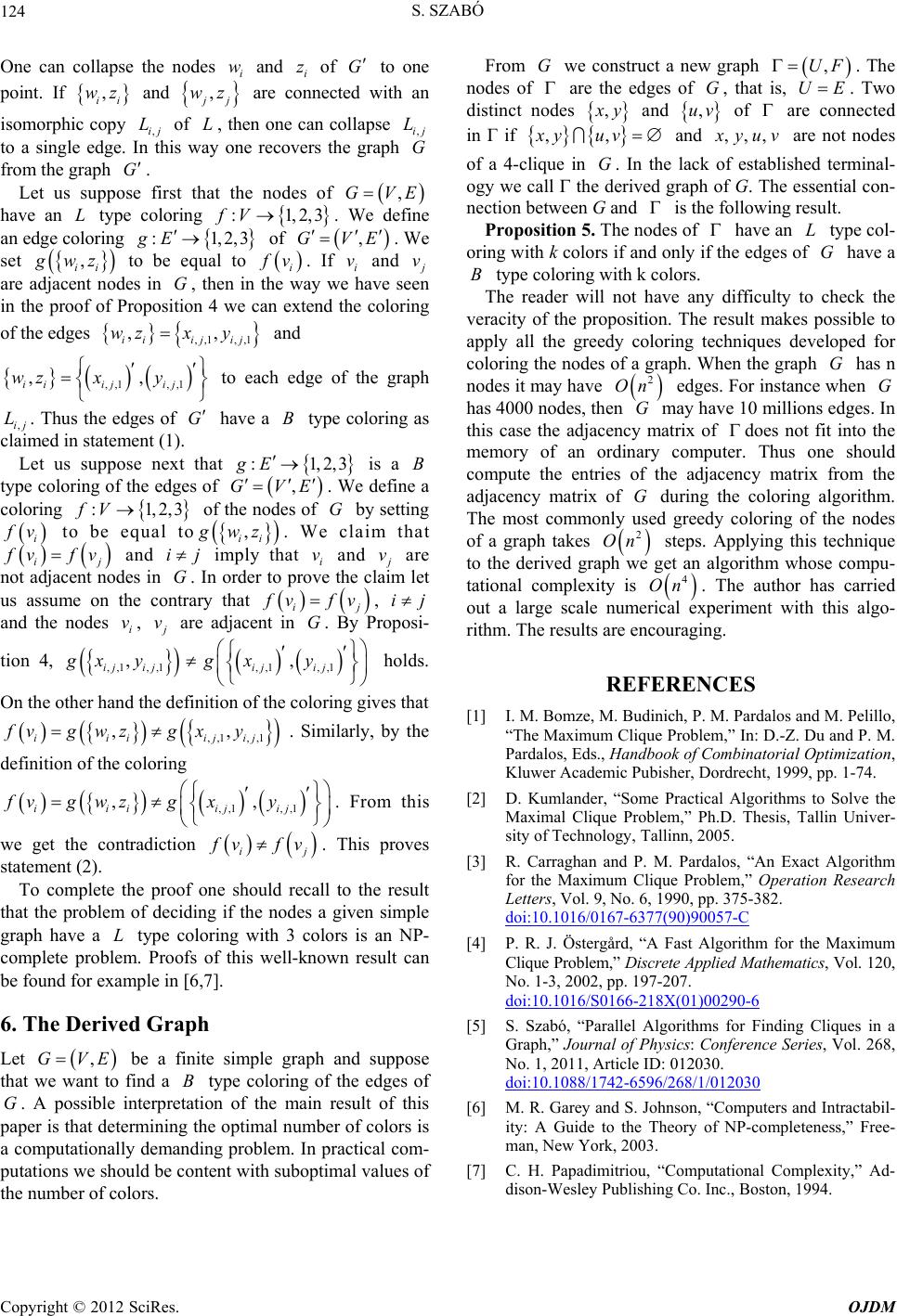 S. SZABÓ Copyright © 2012 SciRes. OJDM 124 One can collapse the nodes and of G i wi z to one point. If and , ii wz , j wz are connected with an isomorphic copy ,ij of , then one can collapse to a single edge. In this way one recovers the graph from the graph . L G L,ij LG Let us suppose first that the nodes of ,GVE E . We 3 ,V have an type coloring . We define an edge coloring :g G set L , ii 1: ,2, 2,3 of fV 1,E wz be equal to to i vi v and . If v e adjacent nodes in G, then in the way we have seen in the proof of Proposition 4 we can extend the coloring of the edges ,,1 ,,1 ,, i iijij wzx y and ar h ee graph Thus the edges of a tha is a ty ,,1 ,,1 ,, i iijij wz xy to eac have t dge :1 of th type coloring as ,2,3 ,ij L. clai G B med in statement (1). Let us suppose next gE B pe coloring of the edges of ,GV coloring E . We define a :1,2,3fV of tG by setting i he nodes of v to , be equal toii wz . We claim that fv and ijat i v and fv ij imply th v are des in In order to proe the claim let us assume on the contrary that i fv fv, ij not adjacent noG. v j and the nodes i v, v are adjacent in ro G ,, . By Pposi- tion 4, ,,1 ,,1,,1,,1ijijijij gx yg xy g giv holds. On the other hand the definitiohrines tn of te colohat ,,fvg wzg xy . Similarly, by the ,, ,1iii i1 ,ij ,,1i j ,1i definition of the coloring m we get the contradiction ,, ,iii jj fvg wzgxy . Fro this ij vfv ld recall t graph a . This o th nd su proves the proof onoue result th 6. The Derived Graph ple ppose pa From we construct a new graph . The nodes of G ,UF are the edges of , that is, UGE . Two distinct nodes , y and of are connected ,uv ,,uvxy statement (2). To completee sh at the problem of deciding if the nodes a given simple graph have a L type coloring with 3 colors is an NP- complete problem. Proofs of this well-known result can be found for example in [6,7]. Let ,GVE be a finite sim that find a B type coloring of the edges of G. A possible interpretation of the main result of this per is that determining the optimal number of colors is a computationally demanding problem. In practical com- putations we should be content with suboptimal values of the number of colors. we want to in Γ if and ,,, yuv are not nodes of a 4-clique in . In the lack of established terminal- ogy we call the derived graph of G. The essential con- nection between G and G is the following result. Proposition 5. The nodes of have an type col- oring with k colors if and only if the edges of have a type coloring with k colors. LG B The reader will not have any difficulty to check the veracity of the proposition. The result makes possible to apply all the greedy coloring techniques developed for coloring the nodes of a graph. When the graph has n nodes it may have G 2 On G G edges. For instance when has 4000 nodes, then may have 10 millions edges. In this case the adjacency matrix of does not fit into the memory of an ordinary computer. Thus one should compute the entries of the adjacency matrix from the adjacency matrix of during the coloring algorithm. The most commonly used greedy coloring of the nodes of a graph takes G 2 On steps. Applying this technique to the derived graph we get an algorithm whose compu- tational complexity is 4 On . The author has carried out a large scale numerical experiment with this algo- rithm. The results are encouraging. REFERENCES [1] I. M. Bomze, M. Budinich, P. M. Pardalos and M. Pelillo, “The Maximum Clique Problem,” In: D.-Z. Du and P. M. Pardalos, Eds., Handbook of Combinatorial Optimization, Kluwer Academic Pubisher, Dordrecht, 1999, pp. 1-74. [2] D. Kumlander, “Some Practical Algorithms to Solve the Maximal Clique Problem,” Ph.D. Thesis, Tallin Univer- sity of Technology, Tallinn, 2005. [3] R. Carraghan and P. M. Pardalos, “An Exact Algorithm for the Maximum Clique Problem,” Operation Research Letters, Vol. 9, No. 6, 1990, pp. 375-382. doi:10.1016/0167-6377(90)90057-C [4] P. R. J. Östergård, “A Fast Algorithm for the Maximum Clique Problem,” Discrete Applied Mathematics, Vol. 120, No. 1-3, 2002, pp. 197-207. doi:10.1016/S0166-218X(01)00290-6 [5] S. Szabó, “Parallel Algorithms for Finding Cliques in a Graph,” Journal of Physics: Conference Series, Vol. 268, No. 1, 2011, Article ID: 012030. doi:10.1088/1742-6596/268/1/012030 [6] M. R. Garey and S. Johnson, “Computers and Intractabil- ity: A Guide to the Theory of NP-completeness,” Free- man, New York, 2003. [7] C. H. Papadimitriou, “Computational Complexity,” Ad- dison-Wesley Publishing Co. Inc., Boston, 1994.
|